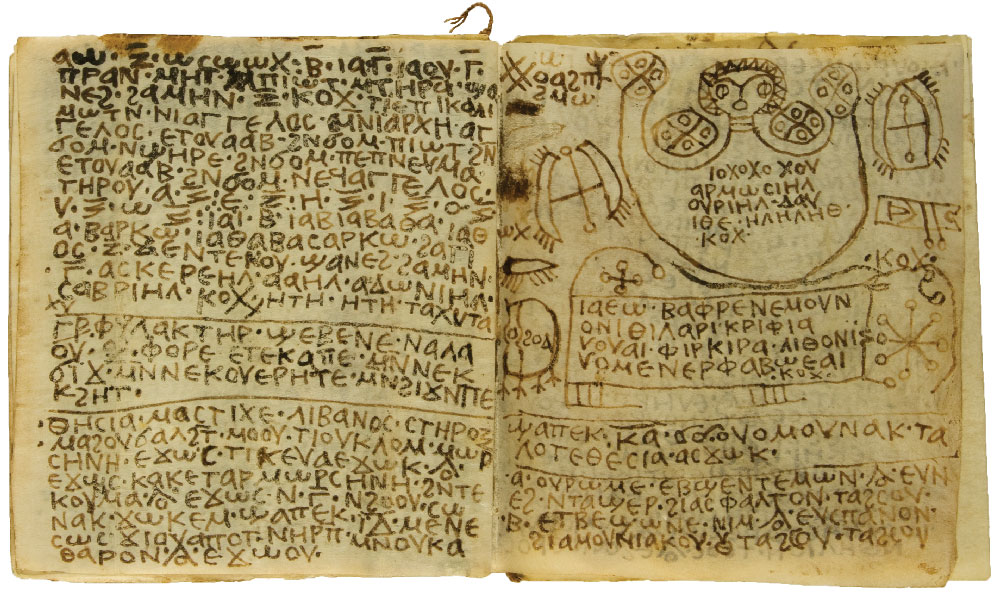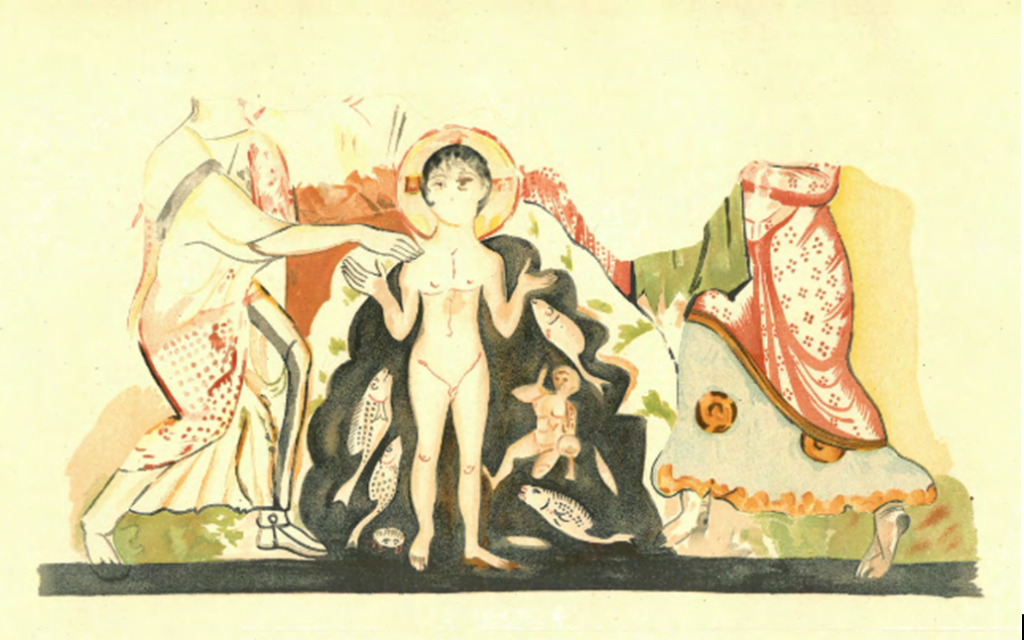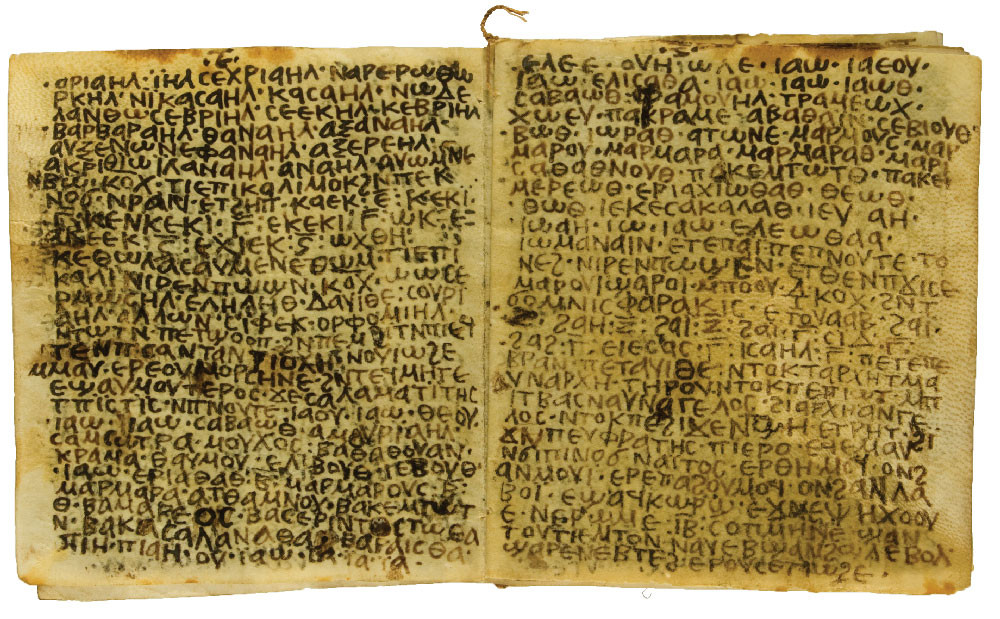
Photo by Ms. Effy Alexakis, copyright Macquarie University Ancient Cultures Research Centre
Last week we introduced Sethian Gnosticism, used to refer to a particular body of Gnostic texts, so-called by scholars because of their shared features, in particularly the importance of Seth as a revealer and saviour. This body of texts is also called “Classic Gnostic”, since it contains many of the features typically associated with “Gnostic” systems.*
In our last post we also looked at how some of the figures which occur in the Sethian system – such as the luminary Davithe – also show up in magical texts. In most cases, we suggested, this is a result of shared cultural background rather than the dependence of Sethian or magical texts upon one another. But we also noted that Iain Gardner had suggested that one particular Coptic magical text, P.Macq. I 1, might have a more direct relationship with Sethian ritual.
In order to introduce this ritual, the baptismal practice known as the “Five Seals”, we will have to discuss other aspects of the Sethian view of the cosmos and salvation. Once again, we will have to simplify, and combine material from different sources; readers who are interested in going deeper are encouraged to look at the references listed below, and in particular to read the original texts preserved in the Nag Hammadi library.
The Sethian account saw the world as the creation of an ignorant, flawed creator god, often named Yaldabaoth, who had nonetheless managed to steal part of the power of the original divine world belonging to his mother, Wisdom (Sophia). In order to save this divine spark, Yaldabaoth was tricked into creating Adam, the first human, and blowing the divine power into them (Adam is at first androgynous) in the form of spirit. Once Adam is divided into their male and female parts – Adam and Eve – the divine realm continues to intervene. In the Apocryphon of John, Jesus appears to Adam as an eagle which sits on the Tree of Life, and teaches him the true knowledge (gnōsis). This knowledge is passed onto Adam and Eve’s one true son, Seth, who is considered the father of the saved human race, the Seed of Seth.
Jesus is seen in the Gospel of the Egyptians as the incarnation of the original Great Seth. While orthodox Christianity saw the key act of Jesus as his death on the cross, Sethians saw Jesus’ role as the passing on of the knowledge of baptism, the ritual through which believers could join the “Seed”, or family, of Seth, and be saved. Scholars have found possible references to this baptismal ritual, the Five Seals, in several texts from the Nag Hammadi library. Because these texts are not ritual instructions, but rather narrative or theological works, it is often unclear how closely they describe an actual ritual, or if a real ritual even took place. John D. Turner, who has written several times about the ritual of the Five Seals, has suggested that the original practice was a real baptism, but that later texts show its development into a more intellectual, mystical practice.

One of the clearest descriptions of the Five Seals is in the Trimorphic Protennoia, a Sethian revelation discourse. This text seems to describe them as a sequence of five ritual actions, each associated with three angelic beings: 1) the putting on of robes; 2) baptism in living water, perhaps referring to a flowing spring or river; 3) enthronement, perhaps involving ritual anointing; 4) glorification; 5) rapture to the light-realm of the Father, perhaps describing an ecstatic vision. In this text, Jesus is the incarnation of Protennoia, or First-Thought, the female aspect of the godhead, rather than of Seth, and she speaks in the first person about how she saved humankind through the baptismal rite (NH XIII 48.12-34):
- Putting on Robes
“And I delivered him to those who give robes (the angels), Yammon, Elasso, Amenai, and they covered him with a robe from the robes of the Light.” - Baptism
“And I delivered him to the baptists and they baptised him, (the angels) Micheus, Michar, Mnesinous, and they immersed him in the spring of the Water of Life.” - Enthronement
“And I delivered him to those who enthrone, Bariel, Nouthan, Sabenai, and they enthroned him from the throne of glory.” - Glorification
“And I delivered him to those who glorify, Ariom, Elien, Phariel, and they glorified him with the glory of the Fatherhood.” - Rapture
“And those who snatch away snatched away, Kamaliel, (name lost), Samblo, the servants of the great holy Luminaries, and they took him into the light-place of his Fatherhood. And he received the Five Seals from [the Light] of the Mother, Protennoia, and it was granted him to partake of the mystery of knowledge, and he became a Light in Light.”
The Gospel of the Egyptians provides another reference, perhaps to a prayer spoken by someone who had just undergone the baptism. It begins with a series of chanted vowels, one of the features shared by magical and gnostic texts:
Iê ieus êô ou êô ôua, really, truly, oh Yesseus Mazareus Yessedekeus, oh living water, oh child of the child, oh glorious name… I have armed myself with an armour of light, I have become light.
NH III, 2 66.8-67.4
The copies we have of these texts date to the fourth century CE, and they are Coptic translations of even older Greek texts, probably from the second or third centuries CE. It seems unlikely that groups using them, or practicing their rituals, survived later than the fifth century – we have no clear mentions of their texts or practices from later Egypt. For this reason, it is very interesting that references to them seem to appear in P.Macq. I 1, a magical codex (modern-style book, rather than roll) dated from its handwriting to the eighth century CE.
P.Macq. I 1 begins with a long invocation, and then continues with 28 short recipes for which the invocation can be used – from divining the future, to healing jaundice and causing someone to fall in love. It begins with a prayer to a mysterious being called Baktiotha – references to attempts to decipher this name, for now inconclusive, can be found below. What is relevant for us here, though, are the dense apparent references to Sethianism.

Pages 5-6 of P.Macq. I 1 (8th century CE). The possible fragment of a Sethian ritual is written on the right-hand page.
Photo by Ms. Effy Alexakis, copyright Macquarie University Ancient Cultures Research Centre
As we have seen, the names of the Sethian luminaries – Davithe, Eleleth, Oriael, and Harmozel – are common in Coptic magical texts, but in this text they all occur together, and they are apparently called luminaries (phōstēres) in the text (2.22-25), something quite rare. There are several other references to figures known from Sethian material, including Barbelo (1.16), and the eagle who sits on the tree of life in the Apocryphon of John (7.20-21). But the passage of the invocation highlighted as particularly important by Iain Gardner is as follows:
By the power of the holy seals, hai (seven times) haê (seven times), hai (seven times), sid (three times), hai (three times), hah (three times), Yesas (three times), Isaêl (three times).
P.Macq. I 1 6.13-16
The reference to the holy seals is our first clue of a possible connection to the ritual of the Five Seals, but there are more. As in the prayer spoken by the newly-baptised individual in the Gospel of the Egyptians, the passage begins with a series of vowels. The prayer in the Gospel was addressed to Yesseus Mazareus Yessedekeus, probably based on the name “Jesus the Nazarene”, who is mentioned elsewhere in the same text (NH III 64.9-15) as being accompanied by three commanders, Iakôbos, Theopemptos and Isaouêl. Gardner has suggested that three of these names occur in a garbled form in the magical text: Sid from Yessedekeus, Yesas from Yesseus, and Isaêl from Isaouêl. These may not sound exactly the same, but we know that names were liable to change in magical texts, with syllables and letters being added and remove. Gardner suggests that this passage may preserve a garbled form of a Sethian prayer along the lines of that found in the Gospel of the Egyptians.
This does not mean that P.Macq. I 1 is a gnostic text, but its invocation might have incorporated elements of Sethian myth and ritual when it was first composed. Gardner suggests that some of the Sethian elements have been downplayed, and deliberately replaced with more orthodox elements – we actually have two other copies of this invocation, and varying degrees of alteration towards something more orthodox could explain some of the differences in the three versions. Until we find more texts containing earlier copies, or a Sethian ritual text on which it might be based, we cannot be certain if Gardner’s hypothesis is correct, but it does seem like a plausible explanation for the Sethian features of this text, and an interesting example of the way in which the magical tradition was able to borrow features of many different traditions, and preserve them for centuries.
Acknowledgements
*I would like to thank Dylan Burns for his helpful comments on this article, and for providing me with a succinct definition of Sethian Gnosticism. Any mistakes which remain are my own.
References and further reading
Brakke, David. The Gnostics: Myth, Ritual and Diversity in Early Christianity. Cambridge, Massachusetts – London, England: Harvard University Press, 2010. URL
Accessible introduction to Sethian Gnosticism, its ideas, history, and sources.
Burns, Dylan M. Apocalypse of the Alien God: Platonism and the Exile of Sethian Gnosticism. Philadelphia, University of Pennsylvania Press, 2014. URL
Another excellent discussion of this Gnostics, especially good for understanding terminological and historiographical questions. The book includes a discussion of Sethian ritual.
Choat, Malcolm. “Gnostic Elements in Ancient Magical Papyri”. In The Gnostic World, edited by Garry W. Trompf, Gunner B. Mikkelsen, and Jay Johnston. Abingdon – New York: Routledge, 2019. URL
Article discussing the relationship between magical and gnostic texts.
Choat, Malcolm, and Iain Gardner. A Coptic handbook of ritual power (p. Macq. I 1). Turnhout: Brepols, 2013.
The publication containing P.Macq. I 1, the codex discussed in this post.
Dosoo, Korshi. “Baktiotha: The Origin of a Magical Name in P.Macq. I 1.” In Coptic Society, Literature and Religion from Late Antiquity to Modern Times. Proceedings of the Tenth International Congress of Coptic Studies, Rome, September 17th-22nd, 2012, and Plenary Reports of the Ninth International Congress of Coptic Studies, Cairo, September 15th-19th, 2008, edited by Paola Buzi, Alberto Camplani and Federico Contardi. Leuven: Peeters, 2016, 1237–1244. URL
Article tracing the origin of the name “Baktiotha” to the Egyptian decans.
Gardner, Iain. “The Sethian Context to a Coptic Handbook of Ritual Power (= P. Macquarie I)”. Proceedings of the 27th International Congress of Papyrology, edited by Tomasz Derda, Adam Łajtar and Jakub Urbanik. Warsaw: University of Warsaw, 2016, 755-766.
Article arguing for Sethian influence on P.Macq. I 1. The author also discusses further possibilities for interpreting the name Baktiotha, focusing on the possibility of a derivation from the Greek alphabetic sequence B-G-D-Z-Th.
Robinson, James M. (director). The Nag Hammadi Library in English. Leiden: E.J. Brill, 1978.
Accessible translations of the main Gnostic texts.
Turner, John D. “From Baptismal Vision to Mystical Union with the One: The Case of the Sethian Gnostics”. Practicing Gnosis: Ritual, Magic, Theurgy and Liturgy in Nag Hammadi, Manichaean and Other Ancient Literature. Essays in Honor of Birger A. Pearson, edited by April D. DeConick, Gregory Shaw, and John D. Turner. Leiden: Brill, 2013, 411-431. URL
Discussion of the ritual of Five Seals in Gnostic texts.

One Comment
Pingback: